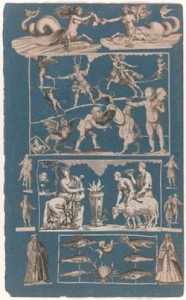 The scholarly research on early modern printmaking has evolved from a focus on the Romantic concept of the Peintre-Graveur to studies of artists and printmakers in their specific cultural and socioeconomic context. In addition, the idea that publishers played a vital role in artistic, commercial, and organisational aspects of printmaking is now widely accepted. Both art-historical and art-technical research on these matters have resulted in reference works and exhibition catalogues of high standard. In these studies, however, the position of the consumer has often been ignored or dealt with only briefly. In addition, print collections in the past have often failed to recognise the importance of contemporary adaptations, signs of usage, and collecting conditions.
The scholarly research on early modern printmaking has evolved from a focus on the Romantic concept of the Peintre-Graveur to studies of artists and printmakers in their specific cultural and socioeconomic context. In addition, the idea that publishers played a vital role in artistic, commercial, and organisational aspects of printmaking is now widely accepted. Both art-historical and art-technical research on these matters have resulted in reference works and exhibition catalogues of high standard. In these studies, however, the position of the consumer has often been ignored or dealt with only briefly. In addition, print collections in the past have often failed to recognise the importance of contemporary adaptations, signs of usage, and collecting conditions.
However, for a proper understanding of early modern culture, it is crucial to study the consumption of printed images and the socioeconomic and artistic processes behind it. Prints were a widespread and artistically diverse medium and the creative process of a print did not stop after printing. Researching the creative afterlife of prints is therefore an essential development in the study of early modern visual culture. Although the consumption and reception of early modern books has received increasing attention in the past decades, only some scholars such as Peter Schmidt ( Gedruckte Bilder in handgeschriebenen Büchern. Zum Gebrauch von Druckgraphik im 15. Jahrhundert , 2003), Jan van der Waals (Prints in the Golden Age: From Art to Shelf Paper , 2006), Kathryn Rudy (Virtual Pilgrimages in the Convent: Imagining Jerusalem in the Late Middle Ages , 2011), and Suzanne Karr Schmidt (Altered and Adorned: Using Renaissance Prints in Daily Life , 2011) have integrated the consumer’s side of the print market and the concrete use of prints in their research.
In order to stimulate this promising evolution, the Rijksmuseum Amsterdam is organising an international conference on early modern prints, ranging from precious artistic prints that were carefully collected to cheap printed images that were used and discarded. Paragons and Paper Bags: Early Modern Prints from the Consumer’s Perspective will take place at the Rijksmuseum on Thursday 9 June 2016.
The aim of this symposium is to further develop this new approach in order to achieve new insights on target audiences, the application and usage of prints, and special collection practices.
The organisers particularly welcome object-based proposals regarding printed pictorial material or written primary sources. Topics for discussion may include, but are not limited to:
Techniques
• Prints with particular engraving or printing techniques, colouring, or multi-sheet compositions, resulting in a special visual or practical experience
Usage and manipulation
• Prints that were applied to objects, furniture or walls
• Prints that were altered by the consumer, deviating from the printmaker’s intentions such as censoring, colouring, and cutting
• Manuscripts and printed books in which prints were added and integrated
• Prints as a source of inspiration for other forms of art
• Prints depicted on other works of art
• Printed primary sources or archival documents on the intended use of specific prints
Target audiences and collection practices
• Print albums that reveal particular contemporary collection practices or the target market for specific prints or print genres
• Prints or primary sources on prints that were created on the initiative of a private individual or professional organisation with a particular purpose in mind
• The appreciation and appraisal of specific prints and printed oeuvres
• Printed primary sources or archival documents on the consumers of early modern prints
• Printed primary sources or archival documents on target audiences of specific prints
The organisation will consider proposals for 20-minute papers, presenting the findings of new or ongoing research. The application, consisting of a proposal abstract (maximum 300 words and an image) and a concise curriculum vitae, should be sent to j.luyckx@rijksmuseum.nl before 1 March 2016. The final program of the conference will be announced later that month.
Scientific Committee
Thomas Döring (Herzog Anton Ulrich-Museum, Braunschweig), Erik Hinterding (Rijksmuseum Amsterdam), Huigen Leeflang (Rijksmuseum Amsterdam), Ger Luijten (Fondation Custodia, Paris), Jeroen Luyckx (Rijksmuseum Amsterdam/ Illuminare – University of Leuven), Mark McDonald (The Metropolitan Museum of Art, New York), Jane Turner (Rijksmuseum Amsterdam), An Van Camp (Ashmolean Museum, Oxford), Peter van der Coelen (Museum Boijmans Van Beuningen, Rotterdam), Jan Van der Stock (Illuminare – University of Leuven), Joris Van Grieken (Royal Library of Belgium, Brussels), Joyce Zelen (Rijksmuseum Amsterdam/ Radboud University Nijmegen)

Leave a Reply
You must be logged in to post a comment.